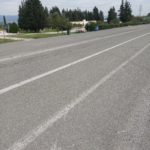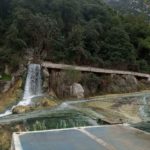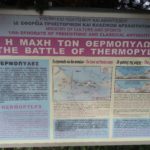Welcome to our fascinating exploration of Thermopylae, the ancient site that witnessed one of history’s most legendary battles. If you’ve ever wondered where Thermopylae is today, you’re in for a treat. Situated in modern-day Greece, this historical landmark continues to captivate visitors from around the world.
Thermopylae holds immense historical significance as the location of the famous Battle of Thermopylae in 480 BC. Here, King Leonidas and his valiant Spartan soldiers stood their ground against the mighty Persian Empire, showcasing unparalleled bravery and tactical brilliance. Today, this hallowed ground beckons curious minds and history enthusiasts eager to uncover its secrets.
Key Takeaways:
- Thermopylae is located in present-day Greece
- It was the site of the Battle of Thermopylae in 480 BC
- King Leonidas and his Spartan soldiers fought against the Persian Empire
- Thermopylae attracts tourists from around the world due to its historical significance
- Explore this ancient site to unravel its mysteries and learn about its heroic past
The Battle of Thermopylae
The Battle of Thermopylae is a prominent event in ancient Greek history that unfolded at the narrow coastal passage of Thermopylae. Led by Spartan king Leonidas, the Greek forces faced off against the mighty Persian Empire. This epic battle is renowned for its display of courage, tactical innovation, and exceptional leadership.
Despite being heavily outnumbered, the Spartan warriors, known for their robust military training and discipline, held their ground for three days. Employing the phalanx formation, they successfully repelled multiple Persian assaults, inflicting heavy casualties on the enemy.
The battle, however, took a turn when a traitor revealed a mountain path that allowed the Persians to outflank the Greek forces. Despite the impending defeat, King Leonidas and a small group of Spartans and Thespians chose to stay behind, sacrificing their lives to cover the retreat of the remaining Greek army.
“Come and take them!” – King Leonidas, in response to the Persian demand for the Greeks to surrender their weapons.
The Battle of Thermopylae
| Key Events | Significance |
|---|---|
| Greek forces led by King Leonidas hold the narrow pass of Thermopylae | Showcased extraordinary courage and tactical prowess |
| Defended against multiple Persian assaults for three days | Inflicted heavy casualties on the Persian army |
| Traitor reveals a mountain path, allowing Persians to outflank the Greeks | Shifted the tide of the battle in favor of the Persians |
| King Leonidas and a small group of Spartans and Thespians stay behind to cover the retreat | Symbolized self-sacrifice and unwavering dedication to their homeland |
Strategic Importance of Thermopylae
The pass at Thermopylae held great strategic importance in ancient times. Situated between Thessaly, Lokris, and Boeotia, it served as a crucial route connecting these regions. The narrowness of the pass made it an ideal defensive position, capable of blocking invaders and providing a significant advantage to defenders. The natural terrain of the area, surrounded by mountains and marshes, added an additional layer of difficulty for any military force attempting to conquer it. These factors made Thermopylae a key location for controlling access to Central Greece and protecting the Greek city-states from invasion.
Throughout history, the defense of the pass at Thermopylae was eventually breached by invaders. However, its strategic importance remained unchanged. The ability to funnel and control the movement of armies through this narrow passage allowed defenders to hold off larger forces and buy valuable time for reinforcement and preparation. Despite the eventual loss of the pass, Thermopylae’s significance as a defensive stronghold and symbol of resistance cannot be understated.
Defending the Pass at Thermopylae
To understand the strategic importance of Thermopylae, one must consider the challenges faced by those attempting to defend the pass. The narrowness of the terrain limited the enemy’s ability to deploy their forces effectively, allowing defenders to concentrate their own troops and maximize their defensive capabilities. The rocky cliffs and the sea on one side further restricted access, essentially creating a bottleneck for any invaders.
In addition to the physical obstacles, defenders could take advantage of the topography to construct defensive fortifications. The Spartans, for example, built a stone wall and utilized their renowned phalanx formation, a tight formation of heavily armored soldiers with overlapping shields, at Thermopylae. This defensive strategy forced the Persians to engage in frontal assaults, which played to the strengths of the Spartan warriors and allowed them to hold their ground against overwhelming odds.
In summary, the strategic importance of Thermopylae cannot be overstated. Its narrow pass and challenging terrain offered defenders a significant advantage in controlling access to Central Greece. Despite being breached by invaders throughout history, Thermopylae remained a symbol of resilience, courage, and the enduring spirit of resistance against tyranny.
| Strategic Advantages | Defenders at Thermopylae |
|---|---|
| Narrow pass | Concentration of troops |
| Rocky cliffs and sea | Restriction of enemy access |
| Difficult terrain | Creation of defensive fortifications |
Historical Battles at Thermopylae
Thermopylae, with its strategic location and historical significance, has been the site of several battles throughout history. In addition to the famous Battle of Thermopylae in 480 BC, there were two other notable conflicts that took place at this iconic pass. These battles showcased the Greek resistance against different invaders, epitomizing their determination to protect their homeland.
Battles at Thermopylae
The first noteworthy battle took place in 279 BC when the Greeks faced an invasion by the Gauls. The Gallic forces, known for their fierce warriors, clashed with the defending Greek forces at Thermopylae. The Greeks, led by the Athenians, managed to repel the Gauls and maintain control of the pass, ensuring the safety of Central Greece.
The second battle occurred in 191 AD when the Roman Empire sought to extend its influence over Greece. The Roman army, led by Emperor Commodus, faced resistance from the Greek city-states at Thermopylae. Despite the Greek’s valiant efforts, the Roman forces eventually breached the pass and gained control of the region.
These battles at Thermopylae underscored the unwavering spirit and resilience of the Greeks in their quest to defend their land against foreign invaders. The historical significance of these conflicts is a testament to the enduring legacy of heroism and the indomitable spirit of the Greek people.
| Date | Battle | Invasion | Outcome |
|---|---|---|---|
| 480 BC | Battle of Thermopylae | Persian Empire | Greek defeat, but significant resistance |
| 279 BC | Battle of Thermopylae | Gauls | Greek victory, repelled the Gauls |
| 191 AD | Battle of Thermopylae | Roman Empire | Greek defeat, Romans gained control |
Geography and Topography of Thermopylae
The geography and topography of Thermopylae are significant factors that contributed to its strategic importance in ancient times. Situated between cliffs and the sea, Thermopylae provided a natural bottleneck that made it difficult for invading armies to pass through. The surrounding mountains and marshes further added to the challenges faced by any military force attempting to navigate the terrain. These geographical features made the defense of Thermopylae more feasible, as it allowed the defending army to control and restrict the movement of their enemies.
Over time, however, the coastline of Thermopylae has changed due to alluvial fans and the progression of the Gulf of Malea. These alterations have modified the appearance of the pass, but its historical significance remains intact. Despite the changes in its physical landscape, the strategic advantages provided by Thermopylae cannot be understated. The narrow passage, steep cliffs, and difficult terrain still serve as a testament to the challenges faced by ancient armies and the importance of careful positioning and defense in warfare.
While there is no specific data for a table in this section, it is worth noting that the geography and topography of Thermopylae played a crucial role in shaping historical events. The natural obstacles and advantages offered by the location influenced military tactics, strategies, and outcomes. The table below provides a summary of the key geographical and topographical features of Thermopylae, demonstrating their impact on the site’s historical significance.
| Geographical Features | Topographical Features |
|---|---|
| Narrow coastal passage | Cliffs |
| Located between cliffs and the sea | Mountains |
| Alluvial fans and changes in coastline | Marshes |
| Obstacle for invading armies | Steep and difficult terrain |
The Battle of Thermopylae: Key Events
The Battle of Thermopylae, fought in 480 BC, was a pivotal moment in ancient Greek history. It marked the heroic stand of King Leonidas and his Spartan warriors against the mighty Persian Empire. Here are the key events that unfolded during this historic battle:
The Greeks’ Initial Defense
The battle began with the Greeks, led by King Leonidas, fiercely defending the narrow pass at Thermopylae. Their compact phalanx formation proved effective in repelling multiple Persian assaults. Despite being heavily outnumbered, the Greeks held their ground for three days, inflicting heavy casualties on the Persians.
The Discovery of the Mountain Path
However, the Persians gained an advantage when a local resident named Ephialtes betrays the Greeks by revealing a mountain path that allows the Persians to outflank their position. This maneuver exposed the Greek forces to a two-front attack, putting them at a severe disadvantage.
Leonidas’ Sacrifice
Despite the dire situation, King Leonidas and a small force of 300 Spartans, along with some Thespians, chose to stay behind and cover the retreat of the rest of the Greek army. Knowing their defeat was inevitable, they fought bravely until the last man, sacrificing their lives for the greater cause of defending Greece against Persian tyranny. Their heroic sacrifice became the epitome of bravery and selflessness.
“Go tell the Spartans, stranger passing by, that here obedient to their laws we lie.” – Epitaph on the memorial of the Spartan dead at Thermopylae
| Event | Description |
|---|---|
| Greeks’ Initial Defense | The Greeks, led by King Leonidas, repel multiple Persian assaults using their phalanx formation. |
| The Discovery of the Mountain Path | A traitor reveals a mountain path to the Persians, allowing them to outflank the Greeks’ position. |
| Leonidas’ Sacrifice | King Leonidas and a small force of Spartans and Thespians stay behind to cover the retreat of the Greek army, ultimately sacrificing their lives. |
The Legacy of the Battle of Thermopylae
The Battle of Thermopylae left an indelible mark on history, leaving behind a legacy that continues to inspire and captivate to this day. The heroism and sacrifice displayed by King Leonidas and his 300 Spartans have become legendary, symbolizing the unwavering human spirit in the face of overwhelming odds. Their resolute stand against the mighty Persian Empire has inspired countless retellings in literature, art, and film.
The Battle of Thermopylae not only showcased the courage and bravery of the Greeks, but it also highlighted the importance of strategy, discipline, and the role of terrain in warfare. The defense of Thermopylae, with its challenging geography and natural bottleneck, demonstrated the significance of utilizing the environment to gain a defensive advantage. Despite their ultimate defeat, the Greeks’ resistance fostered a sense of unity and cultural pride, leading to the Golden Age of Athens and advancements in various fields.
“Go tell the Spartans, stranger passing by, that here obedient to their laws we lie.” – Epitaph on the memorial stone at Thermopylae
The enduring significance of Thermopylae extends beyond its ancient battlefield. The battle serves as a symbol of heroism, sacrifice, and the fight for freedom. It has instilled a deep sense of cultural identity and national pride in Greece, and its impact can be felt in the cultural and intellectual flourishing of the Greek city-states. The legacy of Thermopylae reminds us of the power of human resilience, inspiring us to overcome challenges and strive for greatness.
Table: Legacy of the Battle of Thermopylae
| Legacy | Description |
|---|---|
| Inspiration | The tale of the Battle of Thermopylae inspires courage, determination, and the pursuit of noble ideals in the face of adversity. |
| Cultural Impact | The battle’s legacy resonates in Greek culture, influencing art, literature, and film, and contributing to a sense of national pride and unity. |
| Military Strategy | The defense of Thermopylae emphasized the importance of strategy, discipline, and utilizing the natural environment in warfare. |
| Human Resilience | Thermopylae serves as a reminder of the indomitable human spirit, inspiring individuals to overcome challenges and strive for greatness. |
King Leonidas: The Hero of Thermopylae
King Leonidas, the Spartan king who led the defense at Thermopylae, was a courageous and respected leader. He came from a prestigious lineage, with his bloodline traced back to the hero Hercules. Leonidas ascended to the throne of Sparta after the deaths of his father and older brothers. His character exemplified his dedication to the safety and wellbeing of his people. Despite being heavily outnumbered, Leonidas chose to stand his ground and make a selfless sacrifice to protect the rest of Sparta.
The heroism of King Leonidas and his 300 Spartans has become legendary, symbolizing the indomitable human spirit in the face of overwhelming adversity. Their unwavering resolve and tactical prowess in the Battle of Thermopylae continue to inspire people around the world. Leonidas’ leadership, charisma, and willingness to lay down his life for his people are shining examples of the Spartan warrior ethos.
Leonidas’ legacy extends beyond his military achievements. His actions at Thermopylae highlighted the values of courage, loyalty, and sacrifice that were central to Spartan society. He embodied the ideals of the warrior class and left a lasting impact on the cultural identity of Sparta. Today, King Leonidas remains a symbol of heroism and a reminder of the power of determination and leadership.
| Key Attributes | Impact |
|---|---|
| Courage | Inspired generations with his fearless defense at Thermopylae |
| Leadership | Exemplified strong leadership qualities, motivating his soldiers to fight against overwhelming odds |
| Sacrifice | Chose to stay behind and cover the retreat of the Greek army, ultimately giving his life for the greater cause |
Quote:
“Come back with your shield, or on it.” – King Leonidas to his soldiers before the Battle of Thermopylae
The heroism and sacrifice of King Leonidas at Thermopylae have left an indelible mark on history. His story continues to inspire individuals to embody the values of courage, leadership, and selflessness in the face of adversity. King Leonidas will forever be remembered as a true hero of Thermopylae and a symbol of resilience and bravery.
The Spartan Way of Life
The society of ancient Sparta revolved around military training and discipline. From a young age, Spartan boys were taken from their homes and entered a rigorous training program known as the agoge. This program instilled in them the values of strength, discipline, and endurance, shaping them into formidable warriors. The training included physical exercises, combat training, survival skills, and lessons in loyalty and obedience.
The Spartan way of life also extended to the girls of Sparta. They received physical education and were encouraged to participate in athletic competitions, fostering their physical strength and endurance. This was a unique aspect of Spartan society, as many other Greek city-states did not prioritize the physical education of women.
“No one enters the agoge and leaves unchanged.”
The Spartans believed in the saying, “No one enters the agoge and leaves unchanged.” The military training and discipline instilled in them were meant to cultivate a sense of unity, loyalty, and resilience. This way of life created a strong and cohesive society that was prepared to defend itself against any threat.
Table: Comparison of Spartan Society and Other Greek City-States
| Spartan Society | Other Greek City-States | |
|---|---|---|
| Focus | Military training and discipline | Varied focus on different aspects of life like trade, politics, philosophy, arts, and military |
| Education | Rigorous military training for both boys and girls | Varied education systems depending on the city-state, with minimal emphasis on physical training for girls |
| Social Structure | Highly structured society with a strict hierarchy and a focus on collective identity | Varied social structures depending on the city-state, with a greater emphasis on individual achievement |
| Military Prowess | Known for their exceptional military skills and feared by their enemies | Military strength varied among city-states, with some excelling in specific areas |
Overall, the Spartan way of life was unique and centered around the ideals of military training, discipline, and physical prowess. This societal focus on strength and unity contributed to the success and reputation of the Spartans as fierce warriors.
The Aftermath of Thermopylae
Although the Greeks were ultimately defeated at the Battle of Thermopylae, their valiant stand bought crucial time for the Greek city-states to regroup and prepare for further engagements. This pivotal event in ancient Greek history marked the beginning of a series of Greek victories against the Persian Empire.
Following the Battle of Thermopylae, the Greek navy achieved a significant triumph at the Battle of Salamis, where they forced the Persians to withdraw. This naval victory shifted the balance of power in favor of the Greeks and further bolstered their confidence. Emboldened by their success, the Greeks then secured another decisive win at the Battle of Plataea, which effectively ended the Persian invasion.
Despite the ultimate decline and fall of Sparta as a military power, the Battle of Thermopylae remained a symbol of Greek unity, resistance against tyranny, and the pursuit of freedom. It serves as a reminder of the enduring spirit of courage, sacrifice, and determination that continues to inspire people worldwide.
| Event | Date | Outcome |
|---|---|---|
| Battle of Thermopylae | 480 BC | Greek defeat, but bought time for further engagements |
| Battle of Salamis | 480 BC | Greek naval victory, forced Persian withdrawal |
| Battle of Plataea | 479 BC | Greek victory, ended Persian invasion |
The Enduring Significance of Thermopylae
The Battle of Thermopylae holds an enduring significance in history and has left a lasting impact on culture. Its story of bravery, sacrifice, and the fight against overwhelming odds has been passed down through generations, inspiring numerous retellings in literature, art, and film. This legendary battle symbolizes the indomitable human spirit and the pursuit of freedom.
The cultural impact of the Battle of Thermopylae cannot be understated. It fostered a sense of unity and cultural pride among the Greek city-states, leading to the Golden Age of Athens and significant advancements in various fields. The resilience and determination displayed by King Leonidas and his 300 Spartan warriors serve as a timeless example of courage and heroism.
“Go, stranger, and tell the Spartans that we lie here obedient to their laws.”
This quote, attributed to King Leonidas, encapsulates the enduring significance of Thermopylae. It highlights the unwavering commitment of the Spartans to protect their homeland and defend their way of life. The Battle of Thermopylae became a symbol of Greek unity and the resistance against tyranny, inspiring future generations to stand up against oppression.
The Cultural Impact of Thermopylae
- Inspiration for literature, art, and film
- Fostering a sense of unity among Greek city-states
- Symbolizing courage, sacrifice, and the fight against adversity
- Contributing to the cultural and intellectual flourishing of the Greeks
| Impact | Details |
|---|---|
| Inspiration for Literature | Works such as “The 300 Spartans” and “Gates of Fire” |
| Artistic Representations | Paintings, sculptures, and other art forms depicting the battle |
| Cinematic Legacy | Blockbuster films like “300” bringing the story to a global audience |
Conclusion
The Battle of Thermopylae stands as a testament to the enduring impact of heroism and the pursuit of liberty. This historic event continues to captivate the imagination of people worldwide, symbolizing courage, sacrifice, and determination. King Leonidas and his Spartan soldiers displayed unwavering bravery in the face of overwhelming odds, leaving a legacy that has inspired generations.
Thermopylae’s significance extends beyond the ancient battlefield. It represents the resilience of the human spirit and the fight for freedom. The battle’s cultural and intellectual impact on the Greek city-states cannot be overstated, contributing to the Golden Age of Athens and advancements in various fields.
Today, Thermopylae serves as a popular tourist destination, allowing visitors to explore the site and learn about its historical importance. It reminds us of the indomitable human spirit and the power of heroism in the face of adversity. Thermopylae will forever hold its place in history as a symbol of courage, sacrifice, and the enduring pursuit of liberty.
FAQ
Where is Thermopylae located today?
Thermopylae is a historical site located in present-day Greece.
What happened at the Battle of Thermopylae?
The Battle of Thermopylae was a conflict in 480 BC where King Leonidas and his Spartan soldiers fought against the Persian Empire.
Why is Thermopylae significant?
Thermopylae was strategically important due to its location and its role in defending access to Central Greece.
How many battles took place at Thermopylae?
Thermopylae was the site of several battles throughout history, including conflicts in 480 BC, 279 BC, and 191 AD.
How did the geography of Thermopylae affect the battles?
The natural features of Thermopylae, such as cliffs and marshes, created a challenging terrain for military operations.
What were the key events of the Battle of Thermopylae?
The Greeks, led by King Leonidas, initially held their ground at the narrow pass and repelled Persian assaults. However, a traitor revealed a mountain path, leading to an outflanking maneuver.
What is the legacy of the Battle of Thermopylae?
The battle’s legacy symbolizes courage, sacrifice, and the fight against overwhelming odds. It inspired future generations and contributed to the cultural and intellectual flourishing of the Greek city-states.
Who was King Leonidas?
King Leonidas was the Spartan king who led the defense at Thermopylae. He was a courageous and respected leader, dedicated to the safety and well-being of his people.
What was the Spartan way of life?
Sparta had a unique society focused on military prowess. Boys underwent rigorous military training, while girls also received physical training and participated in athletic competitions.
What was the aftermath of Thermopylae?
Despite the ultimate defeat at Thermopylae, the Greek city-states achieved victories at the Battle of Salamis and the Battle of Plataea, effectively ending the Persian invasion.
What is the enduring significance of Thermopylae?
Thermopylae’s enduring significance lies in its cultural impact, symbolizing heroism and the pursuit of freedom, and inspiring retellings in literature, art, and film.
Source Links
- https://englishpluspodcast.com/the-battle-of-thermopylae-a-detailed-analysis-of-the-iconic-struggle/
- https://www.reed.edu/humanities/110Tech/Thermopylae.html
- https://www.ancientpages.com/2018/07/18/sparta-and-legendary-king-leonidas-the-heroes-of-thermopylae/
Author Profile
-
Welcome to e-thermopyles.gr, your gateway to the fascinating world of Thermopylae and the legendary Spartans. My name is George Margaritis, and I’m the proud owner and writer behind this website.
A Passion for History and the Spartan Legacy
I consider myself fortunate to call the historic site of Thermopylae my home. From a young age, I was captivated by history, and in particular, the incredible tale of the Battle of Leonidas in Thermopylae. The valiant stand of King Leonidas and his 300 Spartans against overwhelming odds has left an indelible mark on the annals of history.
As I delved deeper into this captivating story, my fascination only grew. The bravery, strategy, and sacrifice of those Spartan warriors resonated with me, and I wanted to share this rich history with the world. That’s why I created e-thermopyles.gr, a platform dedicated to exploring and uncovering the depths of knowledge surrounding Thermopylae and the Spartans.
Latest entries
 HistoryOctober 31, 2023Exploring Why is the Battle of Thermopylae Interesting
HistoryOctober 31, 2023Exploring Why is the Battle of Thermopylae Interesting GuidesOctober 31, 2023Your Guide to the Athens to Thermopylae Train Journey
GuidesOctober 31, 2023Your Guide to the Athens to Thermopylae Train Journey GuidesOctober 31, 2023Uncover the Mystery: Where is Thermopylae Today?
GuidesOctober 31, 2023Uncover the Mystery: Where is Thermopylae Today? GuidesOctober 31, 2023Uncover History by Visiting Thermopylae – A Travel Guide
GuidesOctober 31, 2023Uncover History by Visiting Thermopylae – A Travel Guide






